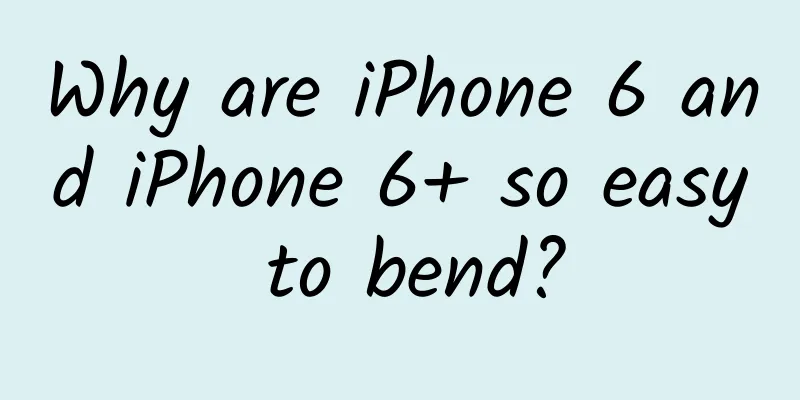Why are iPhone 6 and iPhone 6+ so easy to bend?

|
As someone who has worked on mobile phone structures before, I do have some say. Let me make it clear that I am not engaged in material research, I just design mobile phone structures, so many things do not have strict basis. They are just the experience of my predecessors and the lessons learned from the projects I have experienced. Please be gentle if there are any flaws. First of all, let me explain to you that a lot of experiments need to be done during the development of a mobile phone (not a copycat phone manufacturer). Only after all the experiments can it be said that the design of the mobile phone is complete. I believe that many people only realized that mobile phone testing is also a big deal after watching the debate between Wang Ziru and Lao Luo. Indeed, the number of experiments required in the design verification stage of a mobile phone exceeds your imagination. When we develop mobile phones, we generally reserve at least a few hundred machines for destructive experiments. Among these experiments, there is one that is closely related to this incident, that is, the soft pressure experiment. This soft compression test is a bit like bending a mobile phone with your hands. Here is an introduction to the soft compression test for mobile phones, which mentions that the national standard is 250N for 1,000 presses. The grip strength of a normal adult is about 500N, which means that the national standard is far lower than the grip strength of a normal person. Therefore, if your mobile phone only barely meets the national standard requirements, it will definitely be miserable in actual use. But please rest assured that no mainstream manufacturers currently conduct experiments based on the national standard, but use standards that are far higher than the national standard. But here comes the problem: I am not from Foxconn, and I really don't know Apple's soft compression standards. There are two situations here. One is that the iPhone 6 did not pass Apple's previous soft compression standards, and Apple lowered the standards for reasons such as progress (for a mobile phone with a one-year development cycle, if there is such a thing, I really vomit blood); the other situation is that it passed the previous soft compression standards, but the actual use of the phone was bent, which means that the standards lag behind the actual situation. I noticed Apple's official response on this matter, "In addition, these phones have stainless steel and titanium inserts to reinforce high-stress areas. We also conduct rigorous testing throughout the development cycle, including three-point bending, pressure point cycling, sitting, twisting, and user research. iPhone 6 and iPhone 6 Plus meet or exceed all of our high quality standards and can withstand the test of everyday daily use." This shows that Apple noticed this problem during the design stage and specifically studied it. I believe this is not Apple being perfunctory, but they really did these things because they thought these studies had fully covered the users' normal usage situations (please note, it is normal usage situations). However, the reality is that no one complained about iPhone 4 and 4S bending, but there were news reports about iPhone 5 and 5S bending. As for iPhone 6, it was reported right after it was released. Do I tell you that I am not surprised at all? Let's analyze the reasons below. First of all, let's clarify one thing. When people say that a phone is bent, they mean that the phone cannot rebound to its original shape after being bent. This does not include the situation where the phone automatically rebounds to its original shape after being bent (this should be easy to understand). This is very important and you will understand it later. Whether a mobile phone is easy to bend depends on two key factors: one is the material and the other is the shape. First of all, let's talk about materials. Based on daily experience, you should be able to feel that among stainless steel, liquid metal (zirconium alloy), aluminum alloy, magnesium alloy, and plastic commonly used in mobile phones, stainless steel has the best comprehensive performance in rigidity (ability to resist deformation) and elasticity; zirconium alloy and magnesium alloy have good rigidity but poor elasticity; plastic has poor rigidity but good elasticity; aluminum has poor rigidity and poor elasticity. (The above is just a general introduction, so professionals should not criticize me. I know that the rigidity of nylon plus glass fiber is not worse than that of metal, but I am not writing a paper, so it's fine if it's about the same.) The second is the shape. You can imagine the phone as a rectangular box with an empty surface. According to daily experience, if the side walls of the box are short, then its strength can only rely on the bottom plate. If the side walls are high, it is difficult to bend the relatively soft material. There is no need to explain the principle. You can feel it and know that this is correct. Strengthening the side walls will definitely contribute greatly to the overall strength. Of course, you can also increase the thickness of the bottom. After understanding the above knowledge, you can analyze the structural changes of these three generations of iPhones with me. The first thing you see on iPhone 4 and 4S is the thick and high stainless steel plate. It is estimated that no one can bend this steel ring with bare hands. And when you disassemble the machine, you can find that there is a stainless steel plate welded inside the steel ring, which is just strong enough. Of course, the glass on both sides also makes a great contribution to the rigidity of the whole machine (although the glass is easy to break, it is still very rigid). iPhone5 and 5S use aluminum, which leads to a sharp drop in the strength of the whole device. Aluminum is relatively soft and is too easy to deform (i.e. it cannot return to its original shape after deformation). Therefore, if a larger force (sitting on it) is applied to it, it will bend directly. When the same force is applied to iPhone4, firstly, the whole device is strong and not easy to bend. Secondly, the force is too large, and the glass will crack first. In terms of structure, the thickness of the whole device is thinner and the side walls are shorter. Referring to the previous box model, the bending resistance is even worse. iPhone 6 and Plus, as you can probably tell, are thinner and bigger. According to the lever principle, the same force applied to the upper and lower edges of the phone will greatly increase the torque on the center, which can also explain why the Plus is bent. The location of the bend is also easy to explain, the volume button, logo position, and power button are at the same horizontal position, and these are the hollowed-out parts of the body, which are also the weakest parts of the body. By now, everyone should understand that Apple is also facing a difficult problem in mobile phone design. Is the structure compromising with the industrial design or is the industrial design compromising with the structure? At present, it seems that Apple is also challenging the limit step by step, but the basic trend is to continuously reduce the reliability of the structure. Because Apple can certainly increase the thickness of the mobile phone (the minimum is only 0.5mm) to enhance the strength of the whole machine, but it did not do so. There must be many reasons, such as the weight and thickness of the whole machine will increase, which will affect the feel, etc. As an important product of a super large company, before making this choice, it must have been carefully evaluated. It must not be as stupid as the Internet says, or arrogant, despise consumers, etc., but calculate the pros and cons clearly, and believe that bending will be a low-probability event, and the thinness of the product can attract more consumers. In short, it is a result of a trade-off, and there is no right or wrong. (Of course, if the actual situation is that Jonathan and Cook imitated Steve Jobs and slammed the table at Apple's hard-working engineers, "I want this design! ! Get it done for me! ... Some people may ask, why do Apple products always bend (Cook supports homosexuality??), and I have never heard of any other manufacturer's products being so easily bent? Putting aside the topicality of the brand (even if the knockoff phone can be bent by naked eye, no one cares), the key reason is that which other company would use a design like Apple? The general design is a large plastic sandwich structure, usually with a front shell (with stainless steel or magnesium alloy inserts), a middle shell (or back shell, usually vacuum plated to look like shiny metal), and a battery cover. Samsung is a typical example of this. Not to mention the rigidity of the magnesium alloy, the plastic around it has good rebound. Even if it is bent, it will rebound immediately, just like it was not bent. Of course, there are all-in-one machines, which are generally made of a plastic shell with a stainless steel or magnesium alloy frame inside, and their strength is beyond doubt. Some people will definitely talk about the M7, as its back is also made of aluminum alloy. Yes, its back is made of aluminum alloy, but what about the sides? The sides are made of thick plastic, and the whole machine is so thick, and there are stainless steel plates reinforced inside the body, so it must be more than enough (when you see that the aluminum alloy battery cover on the back of the Chinese version of HTC ONE can be removed, you should know that the aluminum alloy on its back is just for decoration). Some people talk about ultra-thin machines, but go and see which ultra-thin machine dares to use aluminum alloy as the main frame? And those who have used ultra-thin machines should have experienced that for machines that are too thin, even if you use stainless steel as the main structure, they are still less durable than thick machines, and you always have to be careful. The conclusion is that Apple has to bear the corresponding risks if it insists on using this material and this structure. If a design defect refers to the inherent shortcomings of a certain design solution, then the bending incident can indeed be called a design defect. -------------------------- Supplementary part: Someone reminded me that the M8 also has an all-aluminum back cover like the iPhone 6 (I took it for granted that the M7 and M8 are the same, sorry). I looked carefully at the disassembly pictures and it is indeed the case. However, at a glance, the design of the two is similar, but in fact, there are big differences, and the strength is also very different. Let's take a look at two Apple disassembly pictures: It is divided into two parts, one is the touch screen and display screen fully laminated module, the other is the integrated aluminum alloy back cover. Although there is a thin steel plate at the bottom of the display screen, it is too thin (mainly for the reason) and only serves to protect the display screen. The other function is to have some longer clips to fix the display screen assembly. In this way, the strength of the whole machine is only contributed by the aluminum alloy back cover and the touch screen. Let's take a look at the M8 disassembly picture: A closer look reveals that the aluminum alloy back cover of the M8 is independent, equivalent to a battery cover, and its other main frame is the plastic and stainless steel insert front cover in the middle of the family portrait. More importantly, its thickness is 9.35mm!!! While the Apple is 7.1mm. You should know that the height of the side wall has a significant impact on the bending resistance. This comparison can illustrate the design styles of the two manufacturers. Although both have integrated aluminum alloy back shells, Apple's goal is to be thin and light, while HTC focuses more on solidity and reliability (of course, it may also be that HTC is unable to obtain thin and light components, so it has to go with the flow and simply design it to be more solid and thicker). In short, the conclusion is still the same, Apple sacrificed some reliability in order to make it thinner and lighter. (By the way, if the iPhone 6 is designed to be as thick and heavy as the M8, but not easy to bend, would you still buy it? I wouldn’t) I also want to say that I hope you don't have the illusion that other mobile phones can't be bent. I want to compare whether they are easy to bend under normal use, and the relative strength of different machines. If there is no reasonable standard, it is meaningless to simply do destructive experiments. Someone also reminded me that the M8 is weaker. I don’t know if it’s because the iPhone 6 bending test in this video includes the HTC M8/Moto X comparison . I took a closer look at the bending situation as shown below: According to the above three pictures, the iPhone 6 has only a slight bend, the M8 screen is arched upwards, and the iPhone 6 Plus is obviously bent. Some students may think that this proves that the bend of the iPhone 6 is smaller than that of the M8, which means that the design of the M8 is not very good. But please watch the video carefully. When the screen of M8 bulges, the edge of the aluminum alloy back shell is still straight. The fat man in the video also said that when you use force, the screen will be lifted up, but when you let go, the screen will return to its original position. Based on this, I think the design of M8 is still more solid, and its whole machine is more solid, but its design also has shortcomings, which leads to the screen double-sided adhesive coming off when it is stressed, and the screen bulges. There are two main problems. One is that the back shell has a large arc, so when you bend it with your hands, the center of the phone is easily sunken, and then it hits the screen assembly and lifts it up. After you let go, it returns to its original shape, which means that the phone is more elastically deformed and has not undergone a large deformation, but the center of the back shell should sink a little. Another reason should be that the aluminum alloy back shell of the M8 is too biased towards the battery cover, and the fixation with the front shell is not firm enough (of course, there is no problem in daily use). In general, I still think that the probability of the M8 being permanently bent in real life is much lower than that of the iPhone 6 and Plus. Of course, everyone is welcome to slap me in the face, learn together, and analyze together. (Again, I am just an empirical person, academics should not take it too seriously) As a winner of Toutiao's Qingyun Plan and Baijiahao's Bai+ Plan, the 2019 Baidu Digital Author of the Year, the Baijiahao's Most Popular Author in the Technology Field, the 2019 Sogou Technology and Culture Author, and the 2021 Baijiahao Quarterly Influential Creator, he has won many awards, including the 2013 Sohu Best Industry Media Person, the 2015 China New Media Entrepreneurship Competition Beijing Third Place, the 2015 Guangmang Experience Award, the 2015 China New Media Entrepreneurship Competition Finals Third Place, and the 2018 Baidu Dynamic Annual Powerful Celebrity. |
<<: The "free traffic" policy for the entire network is harmful to both others and ourselves
>>: Android policy tightens: Why doesn’t Samsung take advantage of the situation to back off?
Recommend
Congratulations! Our scientific expedition team successfully reached the summit of Mount Everest
2023 "Peak Mission" Everest Scientific ...
How to apply for WeChat Video Account? How to use WeChat Video Account?
At the beginning of 2020, in a video speech at th...
No less than 3 meters! What does the adjustment of residential floor height standards mean?
Recently, the Ministry of Housing and Urban-Rural...
Artifact recommendation! 10 niche, easy-to-use and high-end operation tools!
It is said that if the underwear is well chosen, ...
Gaomi SEO training: Some points to note when optimizing your website
As a user, we have to aim at the optimization pro...
How much does it cost to develop a mini program for Hegang Dance School? Hegang Dance School Mini Program Development Price Inquiry
Mini programs provide convenience for publicity a...
Samsung S8 is priced cautiously to please Chinese users. Do you buy it?
Samsung's new generation flagship smartphone ...
"China's Sky Eye" releases cosmic electronic music! Netizens: Are aliens singing a little song for us?
Fast Radio Burst (FRB) It is the brightest radio ...
How to plan an offline event at zero cost?
Not long ago, on World Intellectual Property Day,...
How to determine the size of memory space for server rental?
The server configuration includes memory, bandwid...
Now, it’s time to go high-end! The road to another breakthrough for domestic mobile phones
Just after the Spring Festival, Xiaomi mentioned ...
Android 5.0 12 new features detailed explanation
On October 15, 2014, Google released a new Androi...
If mobile phone chips are free, it must be Xiaomi's doing
Although Xiaomi has not launched any new products...
South Korea takes tough measures against Volkswagen's cheating scandal, executives sentenced to one and a half years in prison
On January 6, local time, the Seoul Central Distr...
Xiao Weiqing: English Original Reading Basic Class | Shanghai International Studies University professor leads the reading of The Chronicles of Narnia
Xiao Weiqing: English Original Reading Basic Clas...









